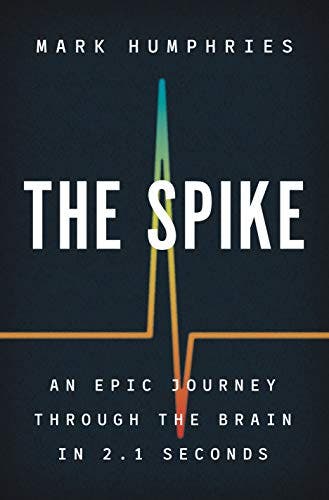Every time you do something — whether that something is solving a math problem, watching TV, or just deciding what to have for lunch — your brain fires a myriad of electric signals to get things going inside your brain, and then soon after, the rest of the body. These electric signals are the cornerstone of our thoughts and actions, they’re how our brains make memories and decisions, how they tell the body what to do (and not do). These spikes make us who we are. This is their story.

“The Spike: An Epic Journey Through the Brain in 2.1 Seconds”
Mark Humphries
Princeton University Press | Buy on Amazon
We’re living in the golden age of neuroscience — or so claims Mark Humphries. Humphries should know, as he has a great deal of experience in the field of neuroscience. Humphries works with computational and statistical models rather than animal models to study the brain and his recent book, The Spike, is an intriguing one for anyone looking to understand how the brain works.
The workhorse of the brain is the neuron, but we’ve only recently started to truly study neurons individually. These “tiny bags of chemicals”, as Humphries calls them, cluster together in gargantuan numbers to process pretty much everything you do — they make you move, think, sleep, and grab cookies. They do it by sending blips of voltage throughout parts of your brain; neuroscientists call these blips “spikes.”
Technically speaking, these spikes are called action potentials, and they’re essentially electrical impulses that send signals around your brain and body. But these electrical signals, simple in essence, paint an extremely nuanced and subtle picture of what goes on in the brain.
Drawing on years of modern research in neuroscience, Humphries takes a look at some of the most pressing questions regarding neurons and spikes. To understand spikes is to understand the brain, but we’re just starting to unravel some of the brain’s mysteries. Why is it, for instance, that most neurons seem silent? Why do neurons sometimes fire spikes without any input, and why do so many spikes fail to reach their destination?
The Spike takes us on a journey to explore those questions — and more. We don’t know many of the answers yet, but we’re getting closer to them, and the journey is rewarding in itself. Going from chemicals that clumped together hundreds of millions of years ago to form what we now call neurons to directing almost everything we do today, neurons have come a long way, and it will take much more research to truly understand how and why they work. But the book does a great job at explaining what we do know so far, and what the likeliest theories are for some of the things neuroscientists are less certain about. The book paints a comprehensive picture of what goes on in the brain (or rather, what we know goes on in the brain), from the single structural unit to the big-picture structures.
The Spike is not always an easy read for people not familiar with neuroscience. Although Humphries uses wit and uses relatable examples (like grabbing a cookie), there are many concepts that may be unfamiliar to the general public. Don’t expect to be done with it in a couple of days — it’ll take a bit of time to get through the book. But the effort is worth it.
However, while some of the building blocks of the book may seem complex and unfamiliar, the story is accessible to a broad range of science enthusiasts. There’s plenty to take from it, whether you’re looking to poke your head into the inner workings of the brain or if you’re a student or researcher in an associated field.
After all, if spikes make up who we are, then it’s a book about ourselves.